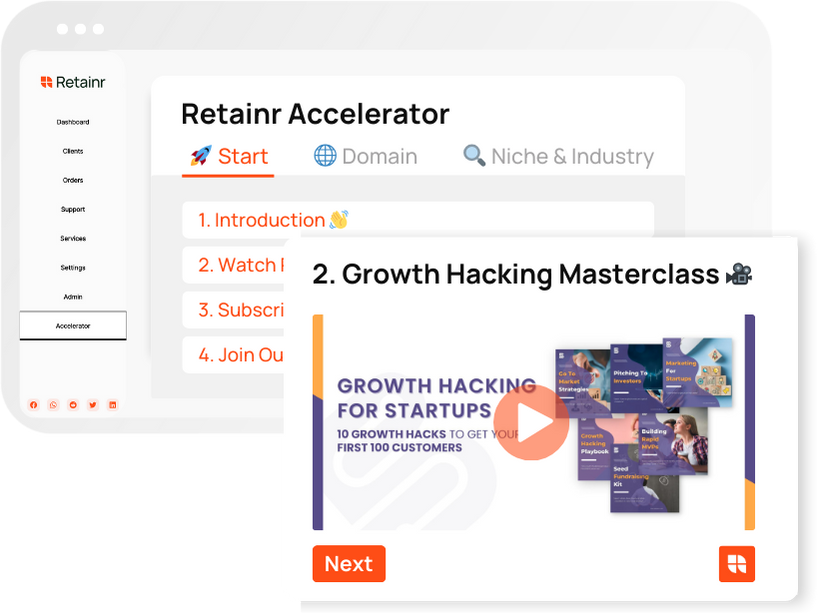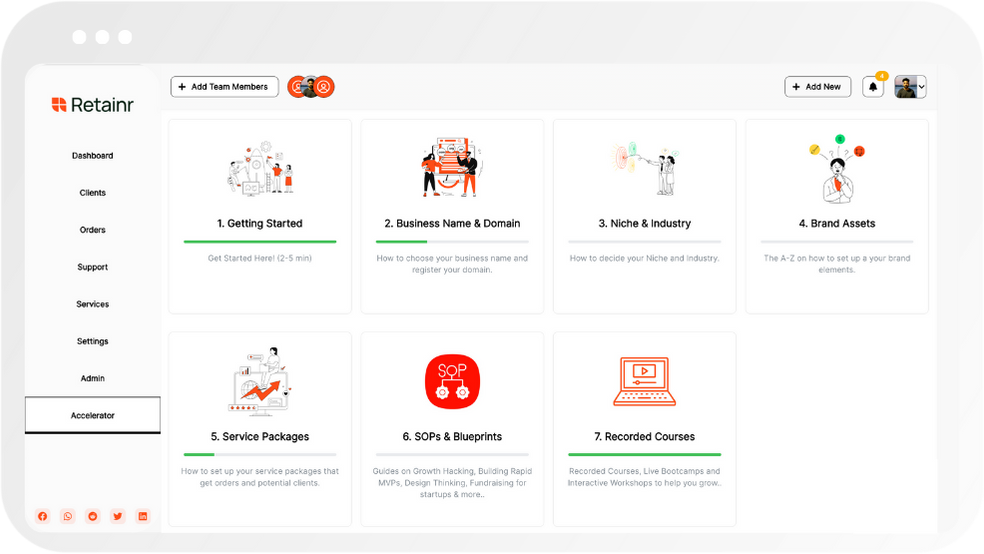
12 Key Elements of a Successful Marketing Strategy
Build with Retainr
Sell your products and services, manage clients, orders, payments, automate your client onboarding and management with your own branded web application.
Get Started1. What are the 12 key elements of a successful marketing strategy?
Understanding the Key Elements of a Successful Marketing Strategy
Developing a robust marketing strategy requires a deep understanding of several foundational factors. Here is an overview of the 12 key elements of a successful marketing strategy:
- Target Audience: Have a clear understanding of who your customers are.
- Unique Selling Proposition (USP): What makes your product or service stand out?
- Competitive Analysis: Identify your competitors and understand their strategies.
- Market Positioning: Determine how your product or service should be perceived in the market.
- Pricing Strategy: Make sure your pricing is competitive and profitable.
- Distribution Plan: Decide where and how you will sell your products.
- Marketing Goals: Have clear, measurable objectives for your marketing efforts.
- Action Plan: This should detail what you'll do to achieve your marketing goals.
- Budget: Decide how much you're willing to spend to achieve your goals.
- Marketing Channels: Determine the best ways to reach your target audience.
- Performance Metrics: Decide how you will measure success.
- Review and Adjustment: Regularly review your strategy and make adjustments if necessary.
More On Marketing Strategy Elements
These key elements can be further understood using a table format:
| Element | Description |
|---|---|
| Target Audience | Understanding the demographics, preferences, and buying habits of your customers. |
| Unique Selling Proposition | Defining what makes your offers different and more desirable than competitors. |
| Competitive Analysis | Understanding the strengths and weaknesses of your competitors. |
| Market Positioning | How you want your target audience to perceive your product or service. |
| Pricing Strategy | Determining what you'll charge for your product or services. |
| Distribution Plan | How, where, and when you'll distribute your product or services. |
| Marketing Goals | Specific, measurable objectives for your marketing efforts. |
| Action Plan | A detailed plan to carry out your marketing goals. |
| Budget | Allocating financial resources to achieve your marketing goals. |
| Marketing Channels | The platforms where you'll promote your product or service. |
| Performance Metrics | Key measurements that will indicate if your strategy is successful. |
| Review and Adjustment | Periodic checks to ensure your strategy is effective and making changes as necessary. |
2. How important are the 12 key elements in creating a marketing strategy?
The Significance of the 12 Key Elements in a Marketing Strategy
The 12 key elements of a marketing strategy are crucial and they play a significant role in the growth and success of a business. Businesses that overlook these elements often struggle to make a significant impact in the market and eventually fail to meet their objectives. Each element contributes to defining the business’s purpose, targeting the right audience, and properly delivering and communicating the brand’s message.
- Value Proposition: This explains why customers should choose your product or services. It helps to differentiate your brand from the competition.
- Target Market: Identify and understand who your product or service appeals to. This helps in focusing your resources and time on the right audience.
- Marketing Channels: These are the mediums through which you communicate your value proposition to your target market. It could be through social media, print, TV ads etc.
To give a clear picture of the elements and their importance, the table below lists the elements, along with their definition and their role in the marketing strategy.
| Element | Definition | Role |
|---|---|---|
| Value Proposition | Reasons why customers should choose your products or services | Helps to stand out from competition |
| Target Market | Identifying who your products or services appeal to | Guides resource allocation and focus |
| Marketing Channels | The mediums used for communicating value proposition | Ensures the message reaches the right audience |
The impact of these 12 elements in making a marketing strategy successful cannot be overstated. They provide a backbone for all marketing efforts and ensure optimal results.
3. Does my marketing strategy need to incorporate all 12 key elements to be successful?
Is Incorporating All 12 Key Elements Necessary?
While it's highly beneficial to incorporate as many elements as possible, it is not a hard necessity to employ all 12 key elements in your marketing strategy to label it successful. Much depends on the nature of your business, the product or service being marketed, and your target clients. Yet, there are a few select elements that are considered beneficial for any type of marketing strategy.
Key Elements to Consider
- Understanding the target market: Regardless of your business type or size, understanding your target market is crucial. This ensures your marketing efforts are directed towards the right audience.
- Crafting a unique selling proposition: The competition in the market is often fierce and to stand out, you must offer something unique to your customers - a unique selling proposition.
- Choosing the right marketing channels: Not every marketing channel may be beneficial for your business. Hence, choose the ones that will yield the most return.
Breakdown of the 12 Key Elements
| Key Element | Description |
|---|---|
| Understanding the target market | Examining and knowing your potential customers and their needs. |
| Crafting a unique selling proposition | A feature or advantage that sets your company apart from competitors. |
| Choosing the right marketing channels | Selecting the appropriate platforms to reach your potential customers. |
4. What will happen if any of the key elements are missing from my marketing strategy?
The Impact of Missing Key Elements in a Marketing Strategy
Any deficiencies in your marketing strategy could have severe consequences for its success. For instance, one scenario could be the failure to reach the target audience effectively, resulting in poor engagement and low sales. In another case, there might be no differentiation from competitors, making it hard for the brand to stand out in a saturated market. Lastly, there might be a lack of clear goals and objectives, which would make it challenging to measure the strategy's success.
Implications of Missing Key Elements
- Unclear Target Market: Without a well-defined target market, the entire marketing plan could fall apart. This often leads to unsuccessful promotional campaigns and poor audience engagement.
- Inadequate Competitor Analysis: Ignoring competitor activities might give competitors room to dominate the market, leading to loss in sales and a diminished market presence.
- No Defined Goals: Not having clear goals and objectives leads to inefficient use of resources and lack of focus in promotional activities.
Consequence Details in Table Format
| Missing Element | Possible Consequence |
|---|---|
| Unclear Target Market | Unsuccessful promotional campaigns, poor audience engagement. |
| Inadequate Competitor Analysis | Loss in sales, diminished brand appreciation and lowered market presence. |
| No Defined Goals | Inefficient use of resources, lack of focus in promotional activities. |
5. Can you provide examples of successful marketing strategies that have utilized all 12 key elements?
Apple's Integrated Marketing Strategy
Apple Inc's marketing strategy showcases all the 12 key elements. The company successfully utilizes market research to thoroughly understand their target audience and their needs. The company's 'I'm a Mac, and I'm a PC' advertising campaign is a shining example of clear and compelling message, positioning Apple as both innovative and user-friendly.
In terms of branding, Apple's sleek design and minimalist aesthetics have created a unique and instantly recognizable identity. Its promotion strategy involves high-profile launches, product placement in popular films and shows, and celebrity endorsement. Their SEO strategy is second to none, and their website is well-optimized to rank well for relevant keywords. They also use social media platforms effectively to engage with their customers and promote their products, as shown by their vibrant presence on Twitter, Instagram, and YouTube.
| Element | Example from Apple's Strategy |
|---|---|
| Market Research | Understanding target audience and their technological needs. |
| Clear Message | 'I'm a Mac, and I'm a PC' campaign. |
| Branding | Sleek design and minimalist aesthetics. |
| Promotion | High-profile launches, product placements, celebrity endorsement. |
| SEO | Effectively optimized website for search engine rankings. |
| Social Media | Active engagement with customers on Twitter, Instagram, and YouTube. |
Nike's Customer-centric Marketing Strategy
Nike’s marketing strategy too encompasses all of the twelve key elements. Central to this is its focus on customer segmentation, as seen in its customization tool NIKEiD that allows customers to personalize and design their own Nike merchandise. It is known for its innovative marketing collaborations, for instance, its collaboration with NBA players.
Nike excels in creating interactive content, from its Nike+ Run Club app to fitness challenges on social platforms. Its memorable visual storytelling is seen in emotive ad campaigns such as "Just Do It". The brand’s user experience is enhanced by their easy-to-use website and seamless customer service, and its influencer marketing strategy has been successful due to endorsements from top athletes.
| Element | Example from Nike's Strategy |
|---|---|
| Customer Segmentation | Customization tool NIKEiD that allows personalization. |
| Marketing Collaborations | Collaborations with NBA players and other athletes. |
| Interactive Content | Nike+ Run Club app and fitness challenges on social platforms. |
| Visual Storytelling | 'Just Do It' campaign. |
| User Experience | Easy-to-use website and seamless customer service. |
| Influencer Marketing | Endorsements and partnerships with top athletes. |
6. How do I implement these 12 key elements into my existing marketing strategy?
Step One: Diagnosis and Analysis
The first step in implementing the 12 key elements of a successful marketing strategy is a comprehensive diagnosis of your current strategy. It's essential to understand what's working and what isn't, why it's working or not, and to identify areas of improvement. Use tools such as SWOT analysis, market research, and customer feedback to collect and analyze data.
- SWOT Analysis - Identify your organizations Strengths, Weaknesses, Opportunities, and Threats.
- Market Research - Understand the market trends, customer behavior, and competition.
- Customer Feedback - Gather information from the customers' perspective about your products and services.
Step Two: Strategy Formulation
The second step is the formulation of your new marketing strategy. This will involve integrating the 12 key elements into your existing strategy. This can be achieved by setting clear objectives, defining your marketing mix, and creating comprehensive marketing plans.
| Marketing Element | Action |
|---|---|
| Clear Objectives | Set SMART (Specific, Measurable, Achievable, Relevant, Time-based) goals for your marketing activities. |
| Marketing Mix | Define your product, price, place, and promotion strategies (the 4Ps of Marketing). |
| Marketing Plan | Create a detailed plan of action for your marketing activities, including timelines and resources needed. |
Step Three: Implementation and Evaluation
The final step is implementing the new marketing strategy and evaluating its effectiveness. Use Key Performance Indicators (KPIs) to measure the impact of the changes you've implemented.
- Implementation: Deploy your new marketing strategy, ensuring all stakeholders are informed about their respective roles and responsibilities.
- Evaluation: Measure the success of your new strategy using relevant KPIs such as sales volume, market share, customer satisfaction, brand awareness, and return on marketing investment.
7. Is there a hierarchy or order to the 12 key elements of a marketing strategy?
Understanding Hierarchy in Strategy Elements
In ideal situations, the 12 key elements of a successful marketing strategy would follow a specific order or hierarchy. This system is crucial to permit a smooth transition between stages and ensure that every aspect is adequately addressed before proceeding to the next. However, it is important to note that this sequence may vary depending on the specific needs and demands of a particular organization or business context.
Typically, it would start with:
- Defining the vision,
- Setting strategic goals,
- Identifying key target audiences,
- Exploring market research,
- And Competitive analysis,
Succeeding Stages in the Plan
The next stages would include:
- Crafting unique value propositions,
- Developing brand messaging,
- Deciding on brand positioning,
- Creating a tactical action plan,
- Execution, and finally,
- Measurement and adjustment.
A Tabular View of the Hierarchy
| Order | Element |
|---|---|
| 1 | Define Vision |
| 2 | Set Strategic Goals |
| 3 | Identify Key Target Audience |
| 4 | Market Research |
| 5 | Competitive Analysis |
| 6 | Craft Unique Value Proposition |
| 7 | Brand Messaging |
| 8 | Brand Positioning |
| 9 | Tactical Action Plan |
| 10 | Execution |
| 11 | Measure And Tweak |
8. Can these 12 key elements be applied to both online and offline marketing strategies?
Applicability of the 12 Key Elements
The 12 key elements of a successful marketing strategy can indeed be applied to both online and offline marketing strategies. These elements pertain to the fundamental concepts of marketing which encompass the understanding of the target market, creating a unique selling proposition, the use of strategic branding, diligent market research, among others. These activities are applicable irrespective of the platform in which the marketing tactics are deployed.
Table 1. Applicability of Key Elements on Different Marketing Strategies| Key Elements | Offline Marketing | Online Marketing |
|---|---|---|
| Understanding the Market | Yes | Yes |
| Unique Selling Proposition | Yes | Yes |
| Use of Strategic Branding | Yes | Yes |
Benefits of the Key Elements in Different Strategies
The use of these elements provides multiple benefits. For offline marketing, these methods facilitate better understanding of customers, differentiating the product from those of competitors, and establishing a strong brand image. The benefits these strategies provide are not limited to offline platforms. For online marketing, understanding consumer behavior, enhanced brand positioning, and effective audience targeting become possible through these key elements.
- Offline Marketing: Better customer understanding, product differentiation, strong brand image
- Online Marketing: Effective consumer behavior understanding, advanced brand positioning, effective audience targeting
9. How can I measure the success of each of these 12 key elements in my marketing strategy?
Measuring Success for Each Key Element
Measuring the success of each key element in your marketing strategy is crucial to determining what is working and what is not working. This can be done in a variety of ways:
- Establishing Key Performance Indicators (KPIs) - These are measurable values that demonstrate how effectively a company is achieving key objectives. They can be used to measure the success of a specific activity or campaign.
- Surveying Customers - Surveys can provide valuable feedback on how well your brand, message, or product is being received. They can also offer insights into areas where improvement is needed.
- Website Analytics - Tools like Google Analytics can measure how well your online strategies are working, tracking things like visitor behavior, conversion rates, and other important metrics.
Detailed Breakdown for Each Key Element's Success
Breaking down the success measurement for each key element can be useful in understanding how each contributes to overall marketing success. Here is a detailed table:
| Key Element | Measurement Method |
|---|---|
| 1. Market Research | Customer Survey Results, Market Trends |
| 2. Target Market | Website Analytics, Market Share Data |
| 3. USP | Customer Feedback, Sales Figures |
| 4. Pricing Strategy | Profit Margins, Revenue Data |
| 5. Promotional Activities | Customer Engagement Rates, KPIs |
Making Adjustments Based on Measurements
After measuring the success of each key element in your marketing strategy, it's important to analyze the results and make necessary adjustments. This might involve tweaking pricing strategies, changing promotional activities, or even redefining the target market. Remember, a successful marketing strategy is not static but constantly evolving based on measurements and market responses.
10. Are there specific industries or markets where these 12 key elements are more effective?
Effectiveness Across Different Industries
The 12 key elements of a successful marketing strategy are universally applicable, regardless of the industry or market. However, let’s take a deeper look at how these principles can especially benefit certain industries.
- Consumer Goods Industry: In the Consumer Goods sector, differentiation (Element #2) and understanding the target consumer (Element #4) can be highly influential. The sector is highly competitive and customers can easily switch brands. Therefore, a clear differentiator and insight into the customer's psyche can go a long way in establishing loyalty.
- Real Estate: For Real Estate, the location and value (Element #3) is paramount. A well-articulated value proposition can sway potential buyers. Also, relationship building (Element #5) is extremely rewarding in this sector, as it's often about creating long-term engagements.
- Technology Industry: The Technology sector stands to gain from fostering innovation (Element #6) and measuring performance (Element #11). Tech companies need to continuously innovate to remain relevant and analytics can help them track their success in a fast-paced industry.
Performance Across Various Markets
Similarly, different markets can benefit from various elements of a successful marketing strategy. Emerging markets vs. mature markets, for example, have diverse requirements and challenges which these elements can address.
| Market | Beneficial Elements |
|---|---|
| Emerging Markets | Differentiation (Element #2), Understanding the target consumer (Element #4) and Creating a strong value proposition (Element #3) |
| Mature Markets | Committing to the market (Element #1), Building relationships (Element #5) and Innovation (Element #6) |
In conclusion, while the universality of these 12 key elements can't be denied, their implementation and influence can vary based on factors specific to certain industries and markets. This flexibility is what makes them essential tools in a marketer's repertoire.
Conclusion
Creating a Successful Marketing Strategy with 12 Key Elements
A successful marketing strategy requires a person to be familiar with 12 key elements. These elements include a clear understanding of your target audience, knowing your unique selling proposition, defining your marketing methods clearly and measuring your results accurately. Other critical factors include leveraging your strengths, understanding digital marketing technologies, and aligning sales and marketing.
Without these key factors, creating a compelling marketing strategy becomes difficult. Luckily, modern technologies such as Retainr.io have been developed to simplify the work and allow you to focus on the elements that are crucial in marketing.
Streamline Your Marketing with Retainr.io
Retainr.io is a comprehensive tool designed to help businesses manage their marketing operations efficiently. This white-label software offers functionality to sell products, manage clients, orders and payments all in one place.
Retainr.io allows businesses to leverage their strengths by providing a platform where you can channel your resources and efforts more productively. The platform eliminates most of the manual processes, allowing you to focus more on strategizing and measuring the success of your marketing campaigns.
Using data from the Retainr.io platform, businesses can gain insights that enable them to fine-tune their marketing strategies. This data-driven approach helps companies to make informed decisions and align their marketing and sales efforts.
By using Retainr.io, you can easily implement and monitor the 12 key elements of a successful marketing strategy. It not only gives businesses an edge in tracking their performance but also helps to streamline operations and drive growth.
To learn more about this revolutionary platform and how it can improve your marketing strategy, visit www.retainr.io today.
Boost Your Agency Growth
with Retainr Accelerator
Uncover secrets, strategies, and exclusive blueprints to take your agency's growth to the next level — from marketing insights to effective presentations and leveraging technology.

SOPs, Cheatsheets & Blueprints
Leverage 50+ SOPs (valued over $10K) offering practical guides, scripts, tools, hacks, templates, and cheat sheets to fast-track your startup's growth.
Connect with fellow entrepreneurs, share experiences, and get expert insights within our exclusive Facebook community.
.jpg)

Join a thriving community of growth hackers. Network, collaborate, and learn from like-minded entrepreneurs on a lifelong journey to success.

Gain expertise with recorded Courses, Live Bootcamps and interactive Workshops on topics like growth hacking, copywriting, no-code funnel building, performance marketing and more, taught by seasoned coaches & industry experts.

.jpg)

.jpeg)


